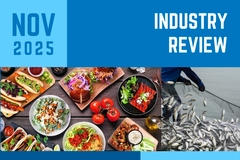
- Industry news
Industry news
- Category news
Category news
- Reports
- Key trends
- Multimedia
Multimedia
- Journal
- Events
- Suppliers
Suppliers
- Home
- Industry news
Industry news
- Category news
Category news
- Reports
- Key trends
- Multimedia
Multimedia
- Events
- Suppliers
Suppliers
Drinktec 2025 preview: Givaudan discusses harnessing influencer insights for disruptive tea concepts

Givaudan has teamed up with social media influencers in a co-creation project to develop new tea concepts that will be showcased during Drinktec in Munich (15-19 September) later this month.
Ahead of the trade show, we take a deep dive into what to expect from Givaudan while examining how working with social media influencers helped the company tap into consumer culture and exciting trends right from the start of concept creation.
With a focus on tea, beer, and soft drink concepts, Givaudan will showcase how its full-service solutions — powered by digital tools and deep consumer insights — can drive faster, smarter product creation and ensure success with consumers.
Givaudan has collaborated with European social media influencers as part of its “Tea Time” program, and come up with six unique tea concepts.

Diego Campos, regional marketing manager – Europe, Givaudan Taste & Wellbeing, tells Food Ingredients First how this collaboration harnessed the insights of key influencers and pioneered new ways to engage, inspire, and co-create. It leverages brand new digital tools and creative storytelling to stay ahead of trends and shape the future of beverages.
What motivated Givaudan to bring social media influencers into the product development process for tea, and how does this approach differ from traditional R&D methods?
Campos: At Givaudan, we see influencers not only as trendsetters but also as cultural translators. They are close to their communities and have a direct pulse on what consumers are curious about, talking about, and aspiring to try next. Very often, we receive requests from customers to “elevate” a concept; to bring in an innovation brief inspired by what influencers are doing online. They take products from the shelf and rework them with twists, transformations, or premium touches that capture attention. By involving influencers early in our process, we could build those creative twists and elevations from the start, rather than retrofitting them later. Traditional development often begins in the lab and moves outward to consumers. With influencer-led co-creation, we reverse that flow, starting with consumer culture and bringing it into the heart of innovation, so our tea concepts are both technically excellent and culturally resonant.
How do you see influencer-led co-creation shaping future beverage development beyond tea?
Campos: Influencer co-creation opens a new way of working that bridges creativity, consumer culture, and product science. Beyond tea, we see it playing a pivotal role in categories like carbonated soft drinks, wellness beverages, and even alcoholic drinks, spaces where emotional connection and differentiation are critical. By combining Givaudan’s expertise in taste and technology with influencers’ ability to spark desire and conversation, we can shorten the gap between consumer trends and market-ready products. It’s not just about co-creating recipes; it’s about co-creating experiences, formats, and narratives that resonate globally.
You identified three core opportunity spaces: healthy hydration, surprising indulgence, and premium formats. How do the tea concepts reflect broader consumer shifts in wellness, indulgence, and premiumization?
Campos: Each of the three opportunity spaces mirrors powerful consumer dynamics we see across beverages: Healthy Hydration taps into the demand for functionality and balance, with teas that bring natural energy, digestive support, or calming properties; answering consumers’ growing need for wellness in every sip. Surprising Indulgence is about joy and sensorial excitement. Our concepts play with unexpected pairings, dessert-inspired notes, and multi-sensorial twists, reflecting how consumers want indulgence that feels playful yet mindful. Premium elevates tea into new occasions, whether through sparkling ready-to-drink (RTD) teas, elegant botanical blends, or limited-edition profiles. This speaks to a wider trend of consumers seeking affordable luxuries that deliver both quality and uniqueness. Together, these directions reflect the way consumers are redefining tea, not just as a beverage, but as a lifestyle choice that delivers wellness, pleasure, and status.
How do digital tools like Myromi and the collaborative process shorten the path from idea to market launch?
Campos: Myromi is a patent-pending handheld aroma delivery device controlled via smartphone. The technology facilitates real-time engagement, enabling users to create new blends while collecting valuable consumer feedback through a customized digital interface. It, therefore, shortens the path from idea to product development. Once connected, users can explore saved aroma profiles, create new blends, leave comments, enter liking scores, and fill out surveys. These capabilities eliminate much of the guesswork involved in formulation. From quickly determining product development direction to landing on the right flavour profile, the device is already delivering results. Traditional methods of gathering consumer feedback can be costly and slow, leading to development delays and reduced chances of success. Myromi tackles some of the biggest challenges faced by product developers through instant feedback. Myromi enables users to capture real-time reactions from customers and consumers. Aromas can be blended and adjusted on the spot through the easy-to-use interface.
With up to eight flavor channels, Myromi aromas can be mixed and matched effortlessly. This means different combinations can be tested in real-time, speeding up the development process. Myromi can be used to help consumers and formulators understand what terminology to use when describing a flavor profile, making feedback easier to interpret. Myromi is lightweight and portable, allowing it to be used anywhere — in the lab, office, or on the road. It offers an easy and affordable way to involve audiences in co-creation, ensuring valuable insights are gained efficiently.
Do you see these tools being used more widely across other beverage segments, such as beer or soft drinks, which you’re also showcasing at Drinktec?
Campos: Absolutely. By offering the possibility to combine multiple aromas, keys, or accords, Myromi can be used for developing aroma profiles for both F&B and fragrance applications. Whether it’s testing flavor profiles for non-alcoholic beers or exploring fantasy-inspired flavors in carbonated drinks, this innovative device empowers brands to co-create flavors and blends that accurately reflect ever-evolving consumer desires. Myromi stands out due to its focus on ease-of-use, user engagement, and qualitative data collection. Unlike larger and more complex technologies, Myromi is lightweight, portable, and cost-effective, allowing for instant feedback and seamless integration into various settings.
How easily can the co-created tea concepts be scaled up for commercial launch, and are you already in discussions with brand partners?
Campos: Scalability is at the heart of our Tea Time program. All concepts were developed with real market application in mind, using technologies and ingredients that can be seamlessly integrated into customers’ innovation pipelines. This means that what began as a co-created prototype can be taken to the pilot stage and scaled commercially without compromise on taste, functionality, or cost. We are already engaging with brand partners across Europe and beyond who see the value in bringing these ideas to life. The influencer-led approach gives them an edge: they’re not only launching a product but tapping into ready-made stories and communities that can accelerate consumer adoption.











